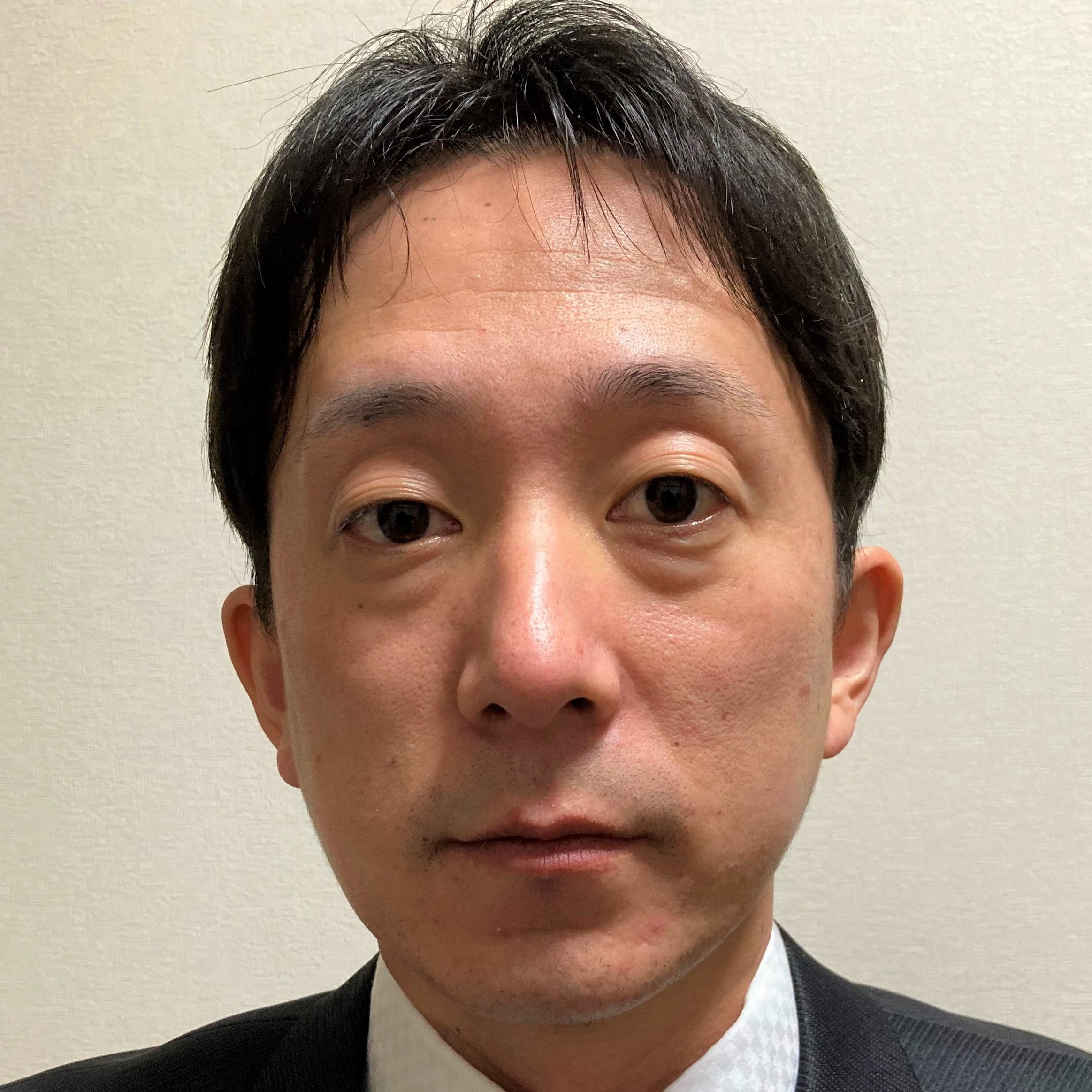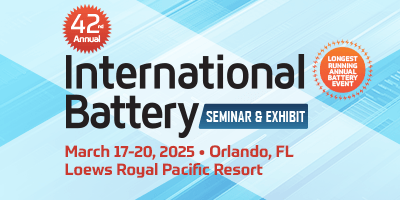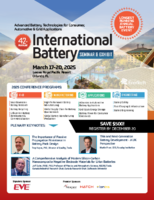Cambridge EnerTechによる
Next-Generation Battery Research
次世代のバッテリー研究
Powering Higher Performance and Energy Density through Electrochemical Engineering
電気化学エンジニアリングによる高性能・エネルギー密度の向上
2025年3月18-19日
リチウムイオンバッテリー(LIB)化学は、技術的限界に達したでしょうか?LIBにおいてエネルギー密度の向上、パワーの増加、寿命の延長、安全性の向上を実現するには、安定したアノード、カソード、電解液を新しく開発し、セパレーター材料を革新する画期的なアプローチが必要です。これには、新しい材料、電極アーキテクチャ、製造技術を効果的に統合するための基礎研究と先端エンジニアリングの両方における協調的な取り組みが必要です。Cambridge EnerTechによる「次世代のバッテリー研究」会議では、幅広い用途でバッテリーの性能を大幅に向上させることを最終目標として、基礎材料研究・電気化学エンジニアリングから診断技術にいたるまで、全範囲を取り上げます。
3月18日(火)
7:00 amRegistration Open and Morning Coffee
INCREASING ENERGY DENSITY: ELECTROCHEMISTRIES
エネルギー密度の増加:電気化学
FEATURED PRESENTATION: New Chemistries for the Electrification of Heavy-Duty Applications (PROPEL-1K Program)
 Halle Cheesman, PhD, Program Director, Advanced Research Program Agency, U.S. Department of Energy (ARPA-E)
Halle Cheesman, PhD, Program Director, Advanced Research Program Agency, U.S. Department of Energy (ARPA-E)
For batteries to contribute in the electrification of planes, trains, and ships, a new generation of ESS will be required. ARPA-E has funded next generation technologies including silicon, solid-state, sodium-ion, and iron-Air, and last July embarked upon a new journey to explore electrochemistries that could achieve 1000Wh/Kg and 1000Wh/Kg. This presentation will discuss the rationale for this program and highlight its Lithium Air, rechargeable LiCFx, and aluminum projects.
Shaping Electrolyte Design for Aqueous Zn-ion Batteries with Molecular Modeling
 Travis P. Pollard, PhD, Chemist, Battery Science Branch, DEVCOM Army Research Laboratory
Travis P. Pollard, PhD, Chemist, Battery Science Branch, DEVCOM Army Research Laboratory
Talk will highlight recent efforts to 1.) limit the extent of hydrogen evolution reaction (HER) and 2.) leverage products generated by HER to improve the reversibility of Zn plating/stripping in aqueous Zn-ion batteries. Emphasis is placed on the role of molecular dynamics and quantum chemistry calculations to address these issues. Topics covered include the development of mixed Zn-K and Zn-Li aqueous electrolytes and sacrificial additives.
Understanding Charge Distribution in Multivalent Batteries
 Jeffrey E. Dick, PhD, Richard B. Wetherwill Associate Professor, Chemistry, Purdue University
Jeffrey E. Dick, PhD, Richard B. Wetherwill Associate Professor, Chemistry, Purdue University
Our research examines the electrochemical behavior of aqueous zinc metal batteries (AZMB), focusing on the pathways of electrons at current collectors during charging. We aim to elucidate the factors that determine an electron's fate, as it can participate in zinc electrodeposition, form a passivation film or solid electrolyte interphase, or engage in the hydrogen evolution reaction. These processes are inherently complex and interconnected, presenting significant challenges for understanding charge distribution.
9:45 amGrand Opening Refreshment Break in the Exhibit Hall with Poster Viewing
INCREASING ENERGY DENSITY: CATHODES
エネルギー密度の増加:カソード
Enabling High Performance Cathode Materials with Conformal Graphene Encapsulation
 Damien Despinoy, CEO and Co-Founder, Volexion
Damien Despinoy, CEO and Co-Founder, Volexion
A novel, scalable, conformal graphene encapsulation solution, co-developed at Argonne and Northwestern University, allows enhanced control of the material/electrolyte interface of Cathode Active Materials (CAM) thanks to a pinhole-free thin graphene layer. It improves cycle life, gassing, rate capability, and voltage and temperature range. This solution also enables next-generation CAM such as earth-abundant chemistries, offering wide temperature operability and immediate usability in existing production lines.
Ultrastable Cathodes Enabled by Compositional and Structural Dual-Gradient Design
 Tongchao Liu, PhD, Assistant Chemist, Chemical Sciences and Engineering Division, Argonne National Laboratory
Tongchao Liu, PhD, Assistant Chemist, Chemical Sciences and Engineering Division, Argonne National Laboratory
Next-generation battery cathodes require high-voltage operation (=4.5V) for greater capacity, cyclability, and thermal tolerance, but existing materials degrade quickly due to structural and electrochemical strain. We present a new cathode with a coherent architecture blending ordered and disordered frameworks with controllable Ni oxidation, enabling stable operation up to 4.7V with minimal capacity fade. Using multiscale diffraction and imaging, we demonstrate that this design is electrochemically and structurally robust, preventing surface degradation and lattice strain. This innovation offers a pathway to overcome voltage limitations and achieve high-performance, long-lasting cathodes.
KEYNOTE PRESENTATION: Sustainable C-LiFePO4 (C-LFP) and C-LiMnxFe1-xPO4 (x=0.1 to 1) (C-LMFP) Cathode Materials for Lithium-ion Batteries
 Karim Zaghib, PhD, Professor, Chemical & Materials Engineering, Concordia University
Karim Zaghib, PhD, Professor, Chemical & Materials Engineering, Concordia University
This presentation offers a comprehensive overview of the entire process involved in the fabrication of C-LFP/LMFP-based lithium-ion batteries, from the initial elements in the mine to the assembly of the final systems that power EVs or energy storage. C-LiFePO4 (C-LFP) and C-LiMnxFe1-xPO4 (x=0.1 to 1) (C-LMFP)-based technologies represent an increasing segment of lithium-ion batteries (LIBs) for electric vehicles (EVs) and energy storage due to desirable properties such as high safety, low cost, and long cycle life.
 Characterization of Lithium Ion Battery Materials
Characterization of Lithium Ion Battery MaterialsBrian Rodenhausen, Lead Scientist, ATS Business Unit Characterization, Anton Paar
Throughout the lithium ion battery production chain, from precursor electrode powders to final cell, material characterization is necessary to ensure intermediates and products are within specification. Anton Paar develops and manufactures premium analytical instrumentation and automated high-throughput testing solutions that are applicable at all stages of production. Examples are numerous and include determination of surface area, particle size, morphology, density, and packing and flow behavior of raw material powders; rheological properties and solids fraction of electrode slurries; adhesion and mechanical properties of electrodes from coating to calendering to drying; pore size and surface chemistry of separators; density, viscosity, and flash point of electrolytes; and in-situ and in-operando characterization of cells by X-ray diffraction. With a controlled supply chain, high-quality manufacturing, a global footprint, and a broad portfolio of solutions, Anton Paar continues to support manufacturers in the lithium ion battery industry in their efforts to develop novel battery materials and ensure high-quality and consistent final products.
12:30 pmNetworking Luncheon
1:15 pmDessert Break in the Exhibit Hall with Poster Viewing
INCREASING ENERGY DENSITY: ANODES
エネルギー密度の増加:アノード
Tackling Lithium Metal Corrosions by Novel Polymeric Coatings
 Xiangbo Meng, PhD, Associate Professor, Mechanical Engineering, University of Arkansas Fayetteville
Xiangbo Meng, PhD, Associate Professor, Mechanical Engineering, University of Arkansas Fayetteville
Lithium (Li) metal has been highly regarded as an ultimate anode for high-energy rechargeable batteries. However, Li suffers from two main serious issues: (1) continuous formation of unstable solid electrolyte interphase and (2) Li dendritic growth. These issues have their roots in Li corrosions chemically and electrochemically. In searching for solutions, recently we have developed several novel Li-containing polymers (named as lithicones) via molecular layer deposition (MLD). The lithicone-protected Li showed compelling long-term cyclability in Li||Li symmetric cells and could dramatically boost the performance of Li||NMC811 (LiNi0.8Mn0.1Co0.1O2) cells, in terms of sustainable capacity and capacity retention.
New Class of High-Performance and Highly-Safe Li-ion Cell Enabled by Novel Vanadium-Based Oxide Anode
 Haodong Liu, PhD, Co-Founder and CTO, Tyfast Energy Corp.; Activate Fellow, Lawrence Berkeley National Laboratory
Haodong Liu, PhD, Co-Founder and CTO, Tyfast Energy Corp.; Activate Fellow, Lawrence Berkeley National Laboratory
We are developing high-performance lithium-ion batteries using a vanadium-based oxide anode for heavy-duty applications such as mining, construction, and military vehicles. These batteries enable faster charging, longer cycle life, and improved low-temperature performance. By utilizing this proprietary vanadium-based anode, we aim to achieve 10x faster charging (<6 mins to 80% SOC), 10x the cycle life (>10,000 cycles), and the ability to charge below freezing (-40°C), while also enhancing safety with the use of a metal oxide anode.
3:20 pmRefreshment Break in the Exhibit Hall with Poster Viewing
PLENARY KEYNOTE
プレナリー基調講演
The Importance of Passive Propagation Resistance in Battery Pack Design
 Troy Hayes, PhD, Director of Quality, Tesla
Troy Hayes, PhD, Director of Quality, Tesla
More than 30 years after the first Li-ion battery was produced, random thermal runaway events still occur in the field. Despite the low probability of such incidents at the cell level, the volume of cells in EVs dictates that manufacturers must prepare for these occurrences. Ensuring that this does not create a significant risk to vehicle occupants is crucial and is a fundamental aspect of battery pack design. This talk will discuss the importance of passive propagation resistance and the rigors of testing given the stochastic nature of Li-ion battery thermal runaway.
A Comprehensive Analysis of Modern Silicon-Carbon Nanocomposite Negative Electrode Materials for Li-ion Batteries
 Jeff Dahn, FRSC, PhD, Professor of Physics and Atmospheric Science, NSERC/Tesla Canada Industrial Research Chair, Canada Research Chair, Dalhousie University
Jeff Dahn, FRSC, PhD, Professor of Physics and Atmospheric Science, NSERC/Tesla Canada Industrial Research Chair, Canada Research Chair, Dalhousie University
There is a huge world-wide push to develop and manufacture modern Silicon:Carbon nanocomposite materials (Si:C) for Li-ion batteries. There are a handful of companies in the US (e.g. Sila, Group 14, etc.), several in Europe as well as OVER 70 companies in China developing and/or manufacturing such materials. Why is this happening? In this lecture I will describe the structure and properties of modern Si:C materials and show why they are so attractive compared to earlier alternatives. The best materials show specific capacities near 2000 mAh/g, first cycle efficiencies near 90%, very little irreversible swelling during charge-discharge cycling and compatibility with simple binders like CMC/SBR. The best materials can be used with typical Li-ion battery electrolytes with common electrolyte additives. We will show results for Li-ion pouch cells containing 20% and 50% by weight of Si:C (balance graphite) where impressive cycle life has been achieved. Energy density increases over "graphite-only" cells are very significant. All the Si:C materials we have tested show large REVERSIBLE volume changes which means that significant care must be taken in cell design.
This and Next-Generation Battery Development-A UK Perspective
 Martin Freer, PhD, CEO, Faraday Institution
Martin Freer, PhD, CEO, Faraday Institution
The UK government set out a battery strategy in 2023 targeting the three elements, including design and development of the batteries of the future as well as strengthen the resilience of UK manufacturing supply chains and enabling the development of a sustainable battery industry. This is matched by a significant delivery program associated with the Faraday Battery Challenge, including the Faraday Institution which coordinates the UK's battery research program. This presentation will provide an overview of the UK's battery strategy, the development of associated research programs, and highlight future focus areas for research and innovation.
5:25 pmReception in the Exhibit Hall with Poster Viewing
6:30 pmClose of Day
3月19日(水)
6:45 amRegistration Open
7:00 amCoffee Talk: Interactive Roundtable Discussions with Coffee & Pastries
Roundtable discussions are informal, moderated discussions with brainstorming and interactive problem-solving, allowing participants from diverse backgrounds to exchange ideas and experiences and develop future collaborations around a focused topic.
TABLE 1: Battery Raw Materials Supply Chain
Moderator: Robert Privette, Manager, Business Development, Rechargeable Battery Materials North America, Umicore USA, Inc.
TABLE 2: Li-ion NMC Fast Charging New Cells for E-Mobility
Moderator: Shmuel De-Leon, CEO, Shmuel De-Leon Energy Ltd.
TABLE 3: Electrolyte Developments: New Components and Approaches
Moderator: Sam Jaffe, Vice President, Battery Solutions, E Source
TABLE 4: Battery Pack System Cost and Safety - Will Future xEV Battery Packs Increase in Complexity or Simplify and How Will Cost and Safety Be Impacted?
Moderator: Kevin Konecky, Battery and Energy Storage Systems Consultant, Total Battery Consulting
TABLE 5: Innovations in Recycling Battery Materials & Second Life
Moderator: Steven Sloop, President, OnTo Technology LLC
TABLE 6: Opportunities and Barriers to Fast Charge in Automotive and Other Applications
Moderator: Brian Barnett, PhD, President, Battery Perspectives
TABLE 7: Provisional Patents to Due Diligence
Moderator: Grant Ehrlich, PhD, Member, Intellectual Property & Technology, Stites & Harbison PLLC
TABLE 8: Understanding the Pressure Effects on Li Metal Batteries
Moderator: Bin Li, Senior Scientist & Joint Professor, Electrification, Oak Ridge National Laboratory
TABLE 9: Challenges and Opportunities in the Distribution of Relaxation Times Analysis
Moderator: Tom Ruether, Lecturer & Chair, Electrical Energy Systems, University of Bayreuth
TABLE 10: How Will Emerging Technologies and Paradigms Impact the Future of Electrified Transportation?
Moderator: Benny Varghese, PhD, Research Engineer, Energy Storage & Advanced Transportation, Idaho National Laboratory
TABLE 11: Battery Testing & Aging
Moderator: Gerald Sammer, PhD, Principal Business Development Manager, AVL List GmbH
TABLE 12: Thermal Runaway
Moderator: Lin Liu, PhD, Professor, Mechanical Engineering, University of Kansas
TABLE 13: Consumer-Driven Trends in Battery Development for Personal Electronics
John Wozniak, PhD, President, ESP Consulting
TABLE 14: Battery Electrolytes: Materials, Developments and Manufacturing
Moderator: Carl Thoemmes, Senior Manager, Orbia Fluor & Energy Materials
INCREASING ENERGY DENSITY: SOLID-STATE BATTERIES
エネルギー密度の増加:SSB
 Enhance Battery Safety and Performance Through thermal analysis and In-Operando Isothermal Microcalorimetry
Enhance Battery Safety and Performance Through thermal analysis and In-Operando Isothermal Microcalorimetry
 Hang Lau, Segment Marketing Mgr, Segment Marketing, TA Instruments
Hang Lau, Segment Marketing Mgr, Segment Marketing, TA Instruments
Thermal analysis techniques are extremely valuable tools for evaluating the thermal stability of battery materials. The decomposition onset temperature, reaction mechanism, and heat of reaction are essential to improving battery safety by design. At the cell level, In-operando isothermal microcalorimetry can simultaneously measure thermal and electrochemical data for a non-destructive determination of performance and stability. Evaluating the thermal properties of a battery during normal operating conditions is crucial for evaluating performance, gaining a deeper understanding of the chemistry, and studying the mechanisms of failure.
New Composite Polymer Electrolytes for High-Performance Li-Metal Batteries
 Chen Liao, PhD, Chemist & Staff Scientist, Chemical Sciences & Engineering, Argonne National Laboratory
Chen Liao, PhD, Chemist & Staff Scientist, Chemical Sciences & Engineering, Argonne National Laboratory
Polymers can serve as composite materials with oxides to provide unprecedented high ionic conductivity and low interfacial resistance for the all solid-state batteries. Here we introduced two approaches, 1) design of single ion conducting polymer electrolytes (SIE); 2) design of crosslinkers. Significant improvements in Li transference number, electrochemical stability, and cycling life are observed with these designs. To improve the anodic stability of polymer electrolytes, a fundamental shift in the building blocks from -CH2-CH2-O- is needed. This is where borate structures come into play, offering both high intrinsic stability and superior interfacial stability.
Managing Electromechanical Heterogeneity in Solid-State Batteries
 Shou-Hang Bo, PhD, Professor, Global Institute of Future Technology, Shanghai Jiao Tong University
Shou-Hang Bo, PhD, Professor, Global Institute of Future Technology, Shanghai Jiao Tong University
In contrast to solid-liquid electrochemical interfacial processes, solid-state batteries must cope with heterogeneous solid-solid interfaces under mechanical constraints. In this talk, I will discuss the development of ultrafast XCT, photoacoustic microscopy, and confocal Raman microscopy, to directly visualize the dynamic evolution of physicochemical fields. An electrode-adaptive Real 2D (R2D) modeling strategy will also be introduced. These lead to innovative ways to manage and control heterogeneity, thus improving electrochemical performance.
10:00 amSponsored Presentation (Opportunity Available)
10:15 amCoffee Break in the Exhibit Hall with Poster Viewing
INCREASING ENERGY DENSITY: SODIUM-ION BATTERIES
エネルギー密度の増加:SIB
Insights on Sodium-ion Battery Performance from 3-Electrode Cells
 Daniel Abraham, PhD, Senior Materials Scientist, Argonne National Laboratory
Daniel Abraham, PhD, Senior Materials Scientist, Argonne National Laboratory
Sodium-ion batteries are gaining increased attention due to considerations that include their cost-effectiveness, sustainability and supply-chain resilience. In this presentation we will discuss insights from 3-electrode cell experiments being conducted at Argonne National Laboratory using layered-oxide cathodes, hard-carbon anodes, and carbonate-based electrolytes. Performance characteristics such as cell capacity fade, impedance rise, voltage-profile changes and the effect of hard-carbon hysteresis and sodium-plating during electrochemical cycling will be discussed.
Advanced Sodium-ion Batteries with Ultra High-Energy Density
 Darren Tan, PhD, CEO, UNIGRID Battery
Darren Tan, PhD, CEO, UNIGRID Battery
Through a breakthrough alloy anode innovation, the energy densities of sodium ion batteries can be increased by a factor of 2x and avoid battery safety hazards, offering competitive advantages in e-mobility and energy storage markets. This session will showcase datasets from state-of-the-art commercial scale sodium ion batteries, with unprecedented energy densities, performance, and rigorous safety testing results of U.S.-made advanced sodium ion batteries.
Chemo-Mechanical Instabilities in Cathode Materials for Na-ion Batteries
 Ozgur Capraz, PhD, Associate Professor, Chemical, Biochemical & Environmental Engineering, University of Maryland Baltimore County
Ozgur Capraz, PhD, Associate Professor, Chemical, Biochemical & Environmental Engineering, University of Maryland Baltimore County
Na-ion cathodes undergo severe chemo-mechanical deformations, which lead to poor capacity retention. Chemo-mechanical deformations can originate from interfacial and structural instabilities. There is a critical scientific need for a comprehensive understanding of the reaction-transport behavior and mechanics of cathodes in Na-ion chemistry. I will present instability mechanisms in battery electrodes by probing operando mechanical deformations during cycling.

Technological Breakthrough Driven by Electrolyte with High Ionic Conductivity
 Hirokazu Kamine, Asahi Kasei Corporation
Hirokazu Kamine, Asahi Kasei Corporation
We present the proof-of-concept (POC) of a lithium-ion battery (LIB) featuring a proprietary high ionic conductive electrolyte developed by Asahi Kasei. Our novel electrolyte significantly outperforms conventional ones, with cells showing superior power at -40°C and doubled cycle life at 60°C before reaching a state-of-health (SOH) of 80%. The use of our electrolyte enhances ionic conductivity and prevents degradation, thus improving battery longevity and performance.
1:00 pmNetworking Luncheon
2:15 pmDessert Break in the Exhibit Hall with Poster Viewing
2:45 pmClose of Conference
* 不測の事態により、事前の予告なしにプログラムが変更される場合があります。
アジェンダ・講演者・スポンサー更新





 Talk Title to be Announced
Talk Title to be Announced Securing the US Battery Supply-Chain via 100% Silicon Anodes to Enable Commercialization of High-Performance Domestic Li-Ion Cells
Securing the US Battery Supply-Chain via 100% Silicon Anodes to Enable Commercialization of High-Performance Domestic Li-Ion Cells
 Talk Title to be Announced
Talk Title to be Announced Talk Title to be Announced
Talk Title to be Announced Talk Title to be Announced
Talk Title to be Announced









 Next-Generation Battery Research
Next-Generation Battery Research High-Performance Battery Manufacturing
High-Performance Battery Manufacturing Advances in Automotive Battery Applications
Advances in Automotive Battery Applications Battery Safety
Battery Safety
